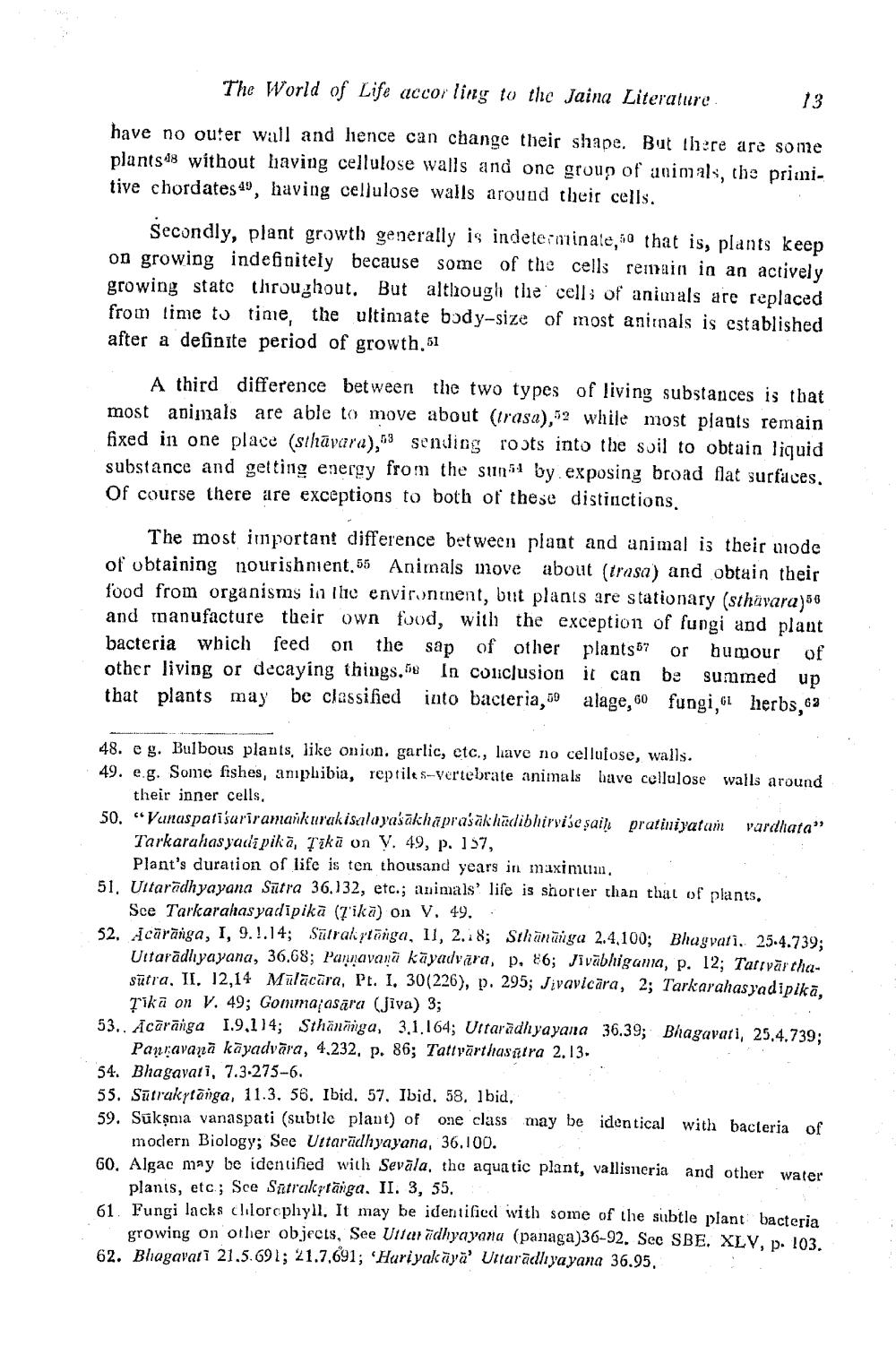________________
The World of Life accor ling to the Jaina Literature
13
have no outer wall and hence can change their shape. But there are some plants as without having cellulose walls and one group of animals, the primi. tive chordates 49, having cellulose walls arouud their cells.
Secondly, plant growth generally is indeterminale, so that is, plants keep on growing indefinitely because some of the cells remain in an actively growing state throughout. But although the cells of animals are replaced from time to time, the ultimate body-size of most aniinals is established after a definite period of growth.51
A third difference between the two types of living substances is that most animals are able to move about (trasa),52 while most plants remain fixed in one place (sthāvara),63 sending roots into the soil to obtain liquid substance and getting energy from the sunsi by exposing broad flat surfaces. Of course there are exceptions to both of these distinctions.
The most important difference between plant and animal is their mode of obtaining nourishnient,55 Animals move about (trasa) and obtain their food from organisms in the environment, but plants are stationary (sthāvara) 58 and inanufacture their own food, with the exception of fungi and plant bacteria which feed on the sap of other plants57 or humour of other living or decaying things. In coliclusion it can be summed up that plants may be classified into bacteria, 59 alage, 60 fungi, 6 herbs, 62
48. eg. Bulbous plants, like onion, garlic, etc., have no cellulose, walls. 49. e.g. Some fishes, amphibia, reptiles-Vertebrate animals have cellulose walls around
their inner cells. 50. “Vanaspatisariramarikurak islayaśākhaprasak hädibhirvise şaih pratiniyatan vardhata"
Tarkarahas yadipikā, Tikä on V. 49, p. 157,
Plant's duration of life is ten thousand years in maximum, 51. Ultaradhyayana Sutra 36.132, etc.; animals' life is shorter than that of plants.
Sce Tarkarahas yadipikā (?'ikā) on V. 49.. 52. Acaränga, I, 9.1.14; Sulrak ytänga, 11, 2.18; Sthānuiga 2.4.100; Bhagvati. 25.4.739;
Uttarādlı yayana, 36.68; Pamavanā kāyadvära, p. 86; Jivābhigama, p. 12; Tatfvārthasütra, II. 12,14 Mūlācāra, Pt. I, 30(226), p. 295; Jivavicāra, 2; Tarkarahasyadipikā.
Tika on V. 49; Gomimaasära (Jiva) 3; 53.. Ācārānga 1.9,114; Sthäniga, 3.1.164; Uttaradhyayana 36.39; Bhagavari, 25.4.739:
Panavanā kāyadvāra, 4.232, p. 86; Tattyärthasarra 2.13. 54. Bhagavati, 7.3.275-6. 55. Sutrakytānga, 11.3. 56. Ibid. 57. Ibid. 58. Ibid. 59. Sükşnia vanaspati (subtle plant) of one class may be identical with bacteria of
modern Biology; See Uttarödhyayana, 36.100. 60. Algac may be identified with Sevāla, the aquatic plant, vallisneria and other water
plants, etc; Sce Satraktānga, II. 3, 55. 61 Fungi lacks chlorophyll. It may be identified with some of the subtle plant bacteria
growing on other objects, See Ullar ūdhyayana (panaga)36-92. Sec SBE. XLV, p. 103. 62. Bhagavati 21.5.691; 21.7.691; 'Hariyakäyä' Uttarādliya yana 36.95.




